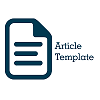THE EFFECT OF USING AUTHENTIC MATERIALS ON READING COMPREHENSION ACROSS SECONDARY STUDENT’ COGNITIVE LEARNING STYLE
(1) Universitas Sari Mulia
(2) Universitas Sari Mulia
(*) Corresponding Author
Abstract
The teaching of reading nowadays is urged to empower students to cope with 21st century literacy challenges and to develop prevailing 21st century. Further, English teachers have to implement interesting and creative materials and strategies to motivate students in learning English. Compared to non-authentic materials, authentic materials seemed more promising to fulfill the demand. The aim of this study was to investigate whether or not the use of authentic materials in the classroom in teaching reading comprehension is effective toward students’ cognitive learning styles. The effect of authentic materials was compared to the non-authentic ones. This study employed a quasi-factorial 2 x 2 design and involved 68 tenth graders SMKN 3 Banjarmasin, South Kalimantan Province. The instruments used were reading comprehension posttest and GEFT. Statistical analysis was performed using SPSS 23.0 to test hypotheses at .05 level of significance. The results showed that authentic materials improved students’ reading comprehension compared to the non-authentic ones. It conforms to the theory of authentic materials and the previous studies indicating authentic material is effective in improving students’ reading comprehension. It was further found that there was no significant difference in the reading comprehension between field independent and field dependent students. Based on the results, it can be concluded that using authentic materials is promising alternative materials to help students increase students’ reading comprehension with different cognitive learning styles.
Keywords
Full Text:
PDFReferences
Abdulhakim, M. Belaid. 2015. Using Authentic Materials in the Foreign Language Classroom. International Journal of Learning and Development. 5 (3):25-38
Almi, S. Hardi. & Bentouzi. 2015. The Effect of Using Authentic Materials in Reading Comprehension for Junior High School Student. Unpublished Thesis. Malang: Universitas Negeri Malang
Altun, A. and Cakan, M. 2006. Undergraduate Students’ Academic Achievement, Field Dependent/Independent Cognitive Styles and Attitued toward Computers. Educational Technology & Society, 9(1), 289-297
Andayani, R. 2011. The Effectiveness of the Teaching Technique with the Non- Linear Note-Taking Technique on Students’ Reading Comprehension as Observed from Students’ Cognitive Learning Styles. Malang: Unpublished Graduate Thesis.
Ary, D., Jacobs, L.C., Razavieh, A., & Sorensen, C. 2010. Introduction to Reasearch in Education (8th ed). California: The Thompson Corporation.
Azri, R.H.A. & Rashdi, M,H.A. 2014. The Effect of Using Authentic Materials in Teaching. International Journal of Scientific and Technology Research.
(10): 249-259
Bacon, S. M., & Finneman, M. D. (1990). A study of the attitudes, motives, and strategies of university foreign language students and their disposition to authentic oral and written input. The Modern Language Journal, 74(4), 459-473. http://dx.doi.org/10.1111/j.1540-4781.1990.tb05338.x
Berardo, S.A. 2006. The Use of Authentic Material in Teaching of Reading: The Reading Matrix: 6(2): 60-69. Available at: http//www.readingmatrix.com/articles/berardo/article.pdf. Retrieved on May 10th 2017.
Chavez, M.T. 1998. Learners’ Perspective on Authenticity. IRAL. 36(4): 270-306 Chinen, C. A. and Boutin, F. 1993. Cognitive Style FD/I: An Important Learner Characteristic for Educational Technologies. Journal of Educational Technology Systems, 21 (4): 303-311.
Crawley, S. J. & Mountain, L. 1995. Strategies for Guiding Content Reading. Boston: Allyn and Bacon.
Ellis, R. (2004). Individual differences in second language learning. In A. Davies & C. Elder (Eds.), The Handbook of Applied Linguistics (pp. 525-551).Oxford: Blackwell Publishing.
Gilmore, A. (2007). Authentic materials and authenticity in foreign language learning. Language teaching, 40(02), 97-118
Guariento, W., & Morley, J. (2001). Text and task authenticity in the EFL classroom. ELT Journal, 55(4)
Kemendiknas. 2016. Standar Kompetensi dan Kompetensi Dasar Mata Pelajaran SMA/MA/SMK/MAK Mata Pelajaran Bahasa Inggris. Jakarta: Kementrian Pendidikan dan Kebudayaan
Khodadady, E. and Zeynali, S. 2012. Field-Dependence/Independence Cognitive Style and Performance on the IELTS Listening Comprehension. International Journal of Linguistics, 4 (3)., 622-635. http://www.macrothink.org/ijil. Retrieved on January 14th 2017
Klingner, J.K., Vaughn, S and Broadman, A. 2007. Teaching Reading Comprehension to Students with Learning Difficulties. London: The Guilford Press.
Latief, M. A. 2016. Research Methods on Language Learning: An Introduction.Malang: UM Press.
Lightbown, P.M. and Spada, N. 2001. How Language are Learned. (2nd Ed).
Oxford: Oxford University Press.
Maghsudi, M. 2017. The Interaction between Field Dependent/Independent Learning Styles and Learners’ Linguality in Third Language Acquisition. Language in India. India: University of Mysore.
Mousavi, S., A., & Iravani, H. (2012). The effect of authentic versus non- authentic aural materials on EFL learners ' listening comprehension. English Language and Literature Studies, 2(1), 21-27.
Nunan, D. (1999). Second language teaching and learning. Boston: Heinle & Heinle publishers.
Peacock, M. 1997. The Effect of Authentic Materials on the Motivation of EFL Learners. ELT Journal. Vol. 51(2): 144-153. Oxford University Press
Saviele-Troike, M. 2006. Introducing Second Language Acquisition. New York: Cambridge University Press.
Solichan, J. 2011. The Effectiveness of Using Authentic Texts in the Teaching Reading Comprehension. Unpublished Master’s Thesis. Malang: State University of Malang
Syafitri, W. 2014. The Impact of Flipped Classroom on Reading Comprehension of High Dchool Students with Different Cognitive Learning Styles.Malang: Unpublished graduated thesis.
Tamo, D. 2009. The Use of Authentic Materials in Classroom. LCPJ, 2(1): 78. Thode, Henry C. 2002. Testing for Hypothesis. New York: Marcel Dekker
Witkin, H. A., Oltman, P. K., Raskin, E., & Karp, S. A. 1971. A Manual for the Embedded Figures Tests. Palo Alto, CA: Consulting Psychologists Press
DOI: http://dx.doi.org/10.31602/intensive.v6i2.8616
Refbacks
- There are currently no refbacks.

Intensive Journal is licensed under a Creative Commons Attribution-ShareAlike 4.0 International License.





